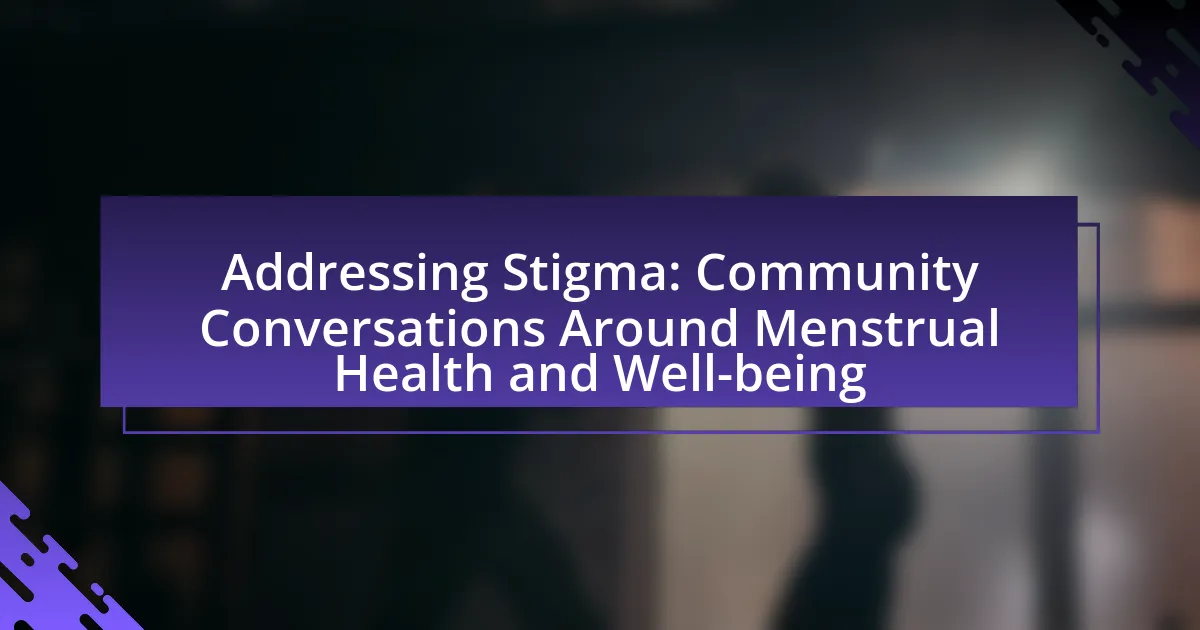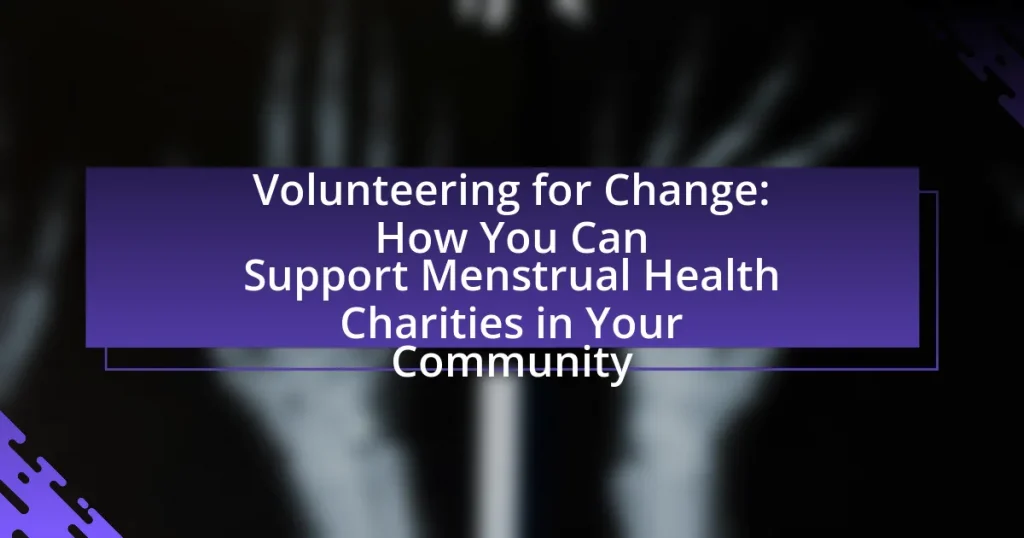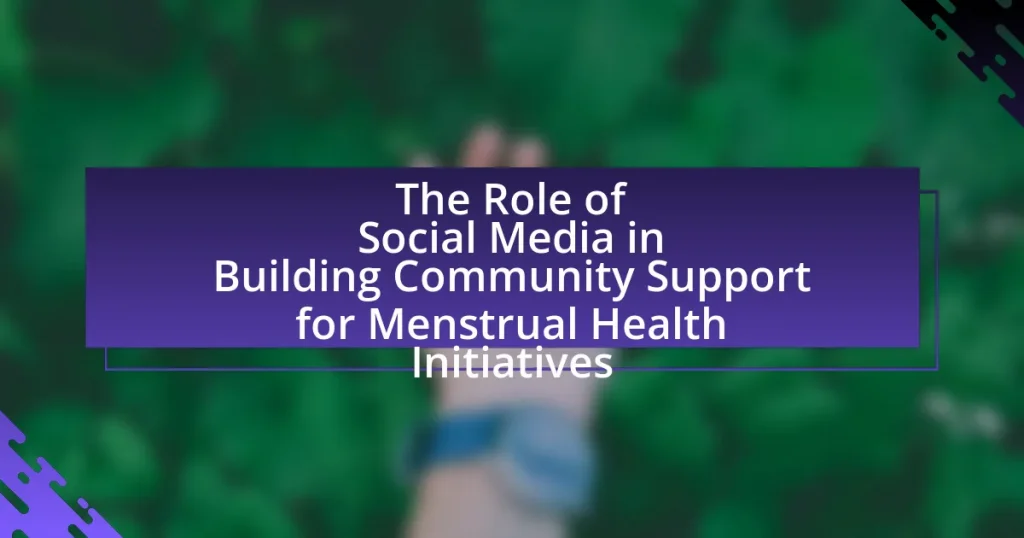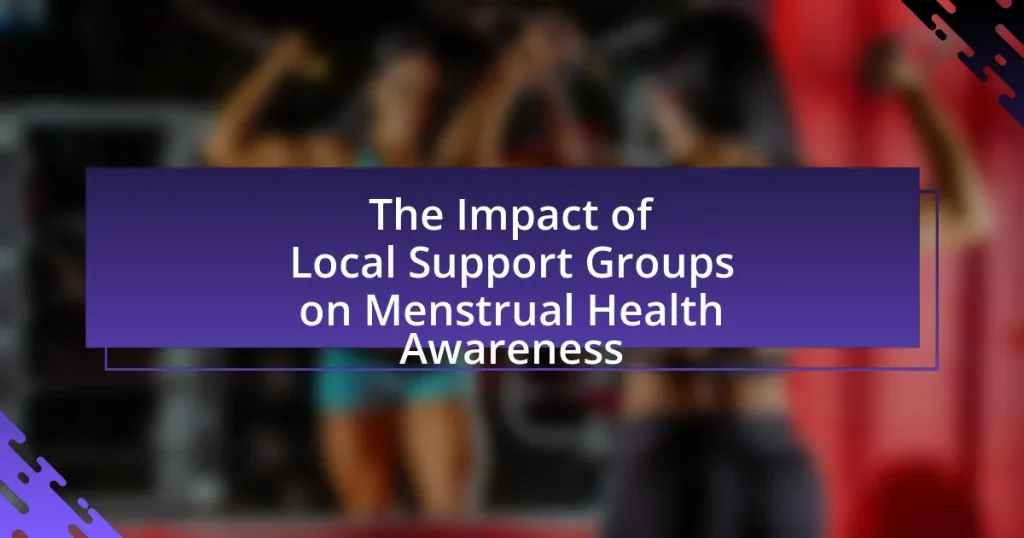The article focuses on the significance of addressing stigma surrounding menstrual health and well-being through community conversations. It highlights how stigma perpetuates misinformation, shame, and barriers to accessing necessary resources, ultimately impacting individuals’ mental and physical health. The article explores the historical roots of menstrual stigma, the role of open dialogue in improving understanding, and the benefits of community engagement in fostering supportive environments. Additionally, it discusses practical strategies for initiating conversations, the importance of educational programs, and the role of local leaders in promoting awareness and reducing stigma related to menstrual health.
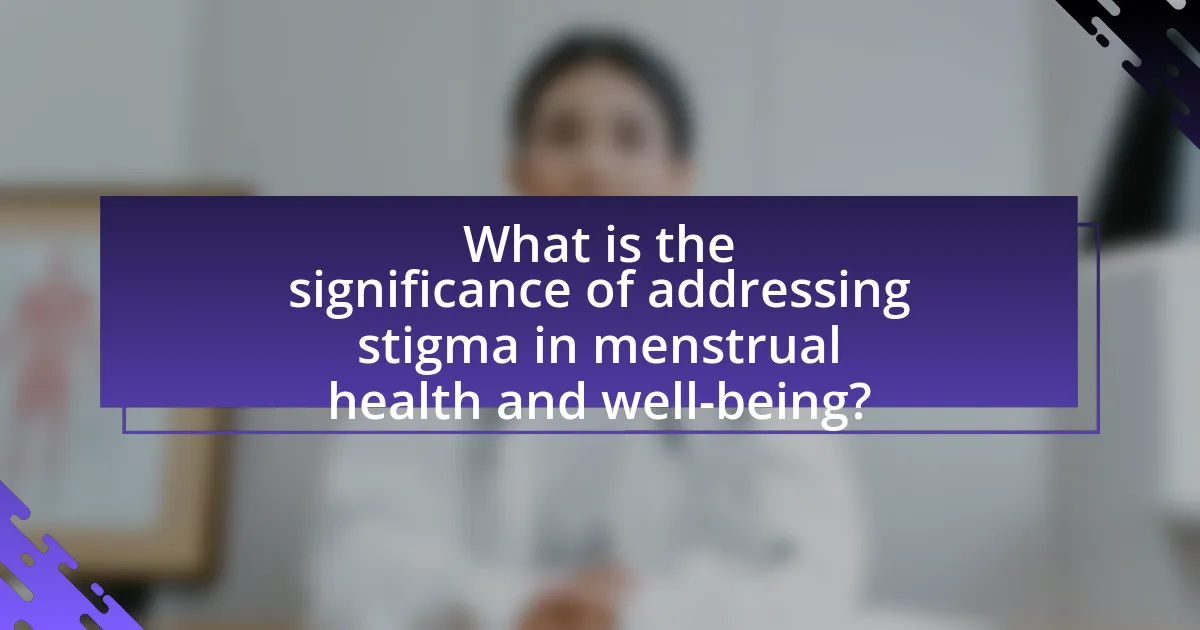
What is the significance of addressing stigma in menstrual health and well-being?
Addressing stigma in menstrual health and well-being is significant because it promotes open dialogue, enhances education, and improves access to necessary resources. Stigma often leads to misinformation and shame, which can hinder individuals from seeking help or discussing their menstrual health openly. For instance, a study published in the journal “BMC Women’s Health” found that stigma surrounding menstruation can negatively impact mental health and lead to social isolation. By addressing this stigma, communities can foster an environment where individuals feel empowered to discuss their experiences, leading to better health outcomes and increased awareness of menstrual health issues.
Why is stigma surrounding menstrual health a critical issue?
Stigma surrounding menstrual health is a critical issue because it perpetuates misinformation and hinders access to necessary health resources. This stigma can lead to feelings of shame and embarrassment among individuals who menstruate, resulting in a reluctance to seek medical advice or support. According to a study published in the journal “Reproductive Health,” 70% of respondents reported feeling embarrassed discussing menstrual health, which can contribute to poor health outcomes and a lack of education on menstrual hygiene management. Furthermore, societal taboos can prevent open conversations about menstruation, limiting awareness and understanding of menstrual health issues, thereby exacerbating the stigma.
What are the historical roots of menstrual stigma?
Menstrual stigma has historical roots in various cultural, religious, and societal beliefs that associate menstruation with impurity and shame. In many ancient societies, such as those in Greece and Rome, menstruating women were often considered unclean and were subjected to restrictions, such as isolation during their menstrual periods. Religious texts, including certain interpretations of the Bible and the Quran, have perpetuated the notion of menstrual impurity, leading to social taboos. Additionally, the lack of understanding of menstruation in historical medical practices contributed to the stigma, as it was often viewed as a sign of weakness or a medical condition rather than a natural biological process. These historical perspectives have shaped contemporary attitudes towards menstruation, resulting in ongoing stigma and silence surrounding the topic.
How does stigma impact individuals’ health and well-being?
Stigma negatively impacts individuals’ health and well-being by creating barriers to accessing necessary healthcare and support. Research indicates that individuals facing stigma related to menstrual health often experience increased anxiety, depression, and social isolation, which can exacerbate physical health issues. For instance, a study published in the journal “BMC Women’s Health” found that stigma surrounding menstruation can lead to lower self-esteem and hinder individuals from seeking medical advice, ultimately affecting their overall health outcomes.
What role do community conversations play in addressing this stigma?
Community conversations play a crucial role in addressing stigma surrounding menstrual health by fostering open dialogue and increasing awareness. These conversations create safe spaces for individuals to share experiences, challenge misconceptions, and educate others about menstrual health issues. Research indicates that community engagement can significantly reduce stigma; for instance, a study published in the Journal of Health Communication found that participatory discussions led to improved attitudes towards menstruation among community members. By facilitating understanding and empathy, community conversations contribute to a more supportive environment, ultimately promoting better menstrual health and well-being.
How can open dialogue improve understanding of menstrual health?
Open dialogue can significantly improve understanding of menstrual health by fostering an environment where individuals feel safe to share experiences and ask questions. This communication helps to dispel myths and misconceptions surrounding menstruation, which are often rooted in cultural stigma. For instance, studies have shown that communities with open discussions about menstrual health report higher levels of awareness and knowledge, leading to better health outcomes. Research published in the journal “BMC Women’s Health” highlights that educational interventions that include open dialogue can increase understanding and reduce stigma, ultimately empowering individuals to manage their menstrual health more effectively.
What are the benefits of community engagement in menstrual health discussions?
Community engagement in menstrual health discussions enhances awareness, reduces stigma, and fosters supportive environments. Engaging communities allows for the sharing of personal experiences, which can normalize conversations around menstruation and challenge societal taboos. Research indicates that when communities actively participate in these discussions, they contribute to improved menstrual health education, leading to better health outcomes. For instance, a study published in the Journal of Adolescent Health found that community-led initiatives significantly increased knowledge about menstrual hygiene management among participants, demonstrating the effectiveness of collective dialogue in addressing menstrual health issues.
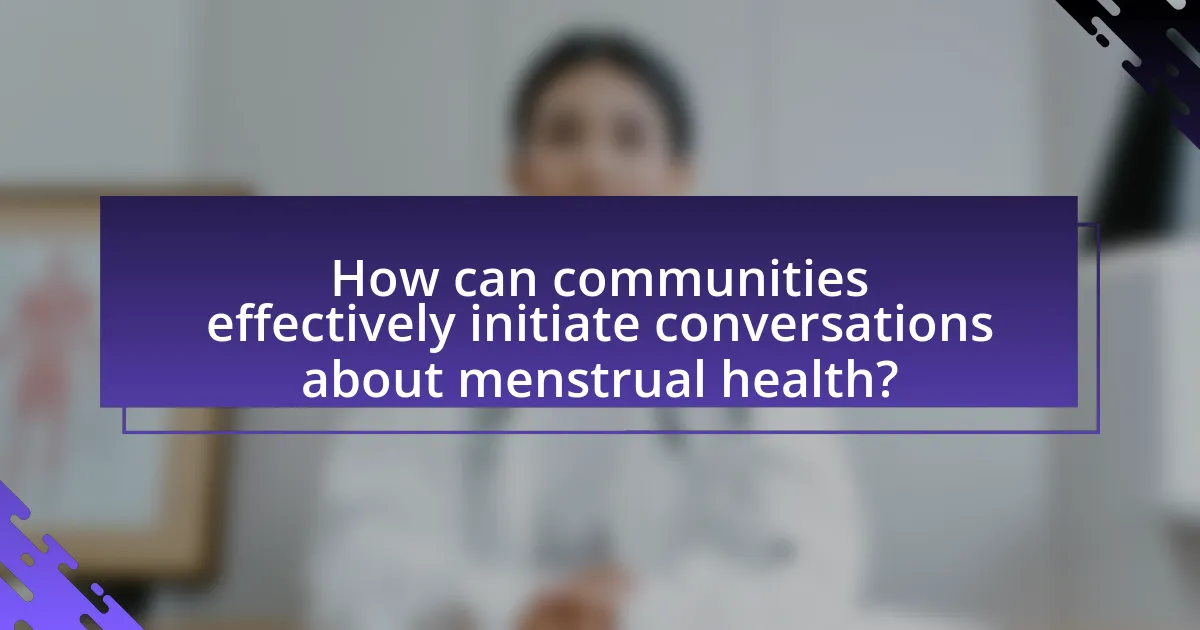
How can communities effectively initiate conversations about menstrual health?
Communities can effectively initiate conversations about menstrual health by creating safe spaces for open dialogue and education. Establishing forums, workshops, or support groups allows individuals to share experiences and knowledge, fostering a supportive environment. Research indicates that educational programs can significantly reduce stigma; for instance, a study published in the Journal of Adolescent Health found that comprehensive menstrual health education improved attitudes and knowledge among participants. Additionally, involving local leaders and influencers can help normalize discussions, as their endorsement can encourage broader community participation.
What strategies can be employed to foster open discussions?
To foster open discussions, creating a safe and inclusive environment is essential. This can be achieved by establishing ground rules that promote respect and active listening, ensuring all participants feel valued and heard. Research indicates that when individuals perceive a space as safe, they are more likely to share personal experiences and engage in meaningful dialogue (Bennett, 2019, “Creating Safe Spaces for Dialogue,” Journal of Community Engagement). Additionally, utilizing open-ended questions encourages deeper exploration of topics, allowing participants to express their thoughts without fear of judgment. Implementing these strategies can significantly enhance the quality and openness of discussions surrounding sensitive subjects like menstrual health and well-being.
How can educational programs be designed to address menstrual health stigma?
Educational programs can be designed to address menstrual health stigma by incorporating comprehensive, age-appropriate curricula that promote open discussions about menstruation. These programs should include factual information about the biological aspects of menstruation, cultural perspectives, and the social implications of stigma. Research indicates that when students engage in discussions that normalize menstruation, it reduces feelings of shame and embarrassment associated with it (Hennegan et al., 2019, BMC Women’s Health). Additionally, involving community leaders and parents in these educational initiatives can foster a supportive environment that encourages dialogue and dispels myths surrounding menstrual health.
What role do local leaders and influencers play in these conversations?
Local leaders and influencers play a crucial role in community conversations about menstrual health and well-being by fostering open dialogue and reducing stigma. They serve as trusted figures who can validate concerns, share accurate information, and encourage community engagement. Research indicates that when local leaders actively participate in discussions about menstrual health, they can significantly influence public perceptions and behaviors, leading to increased awareness and acceptance. For instance, initiatives led by community influencers have been shown to improve knowledge about menstrual hygiene management, as evidenced by programs in various regions that resulted in higher rates of school attendance among menstruating girls.
What challenges might communities face when addressing menstrual health stigma?
Communities face several challenges when addressing menstrual health stigma, including cultural taboos, lack of education, and inadequate access to resources. Cultural taboos often prevent open discussions about menstruation, leading to misinformation and perpetuation of stigma. For instance, in many societies, menstruation is viewed as unclean, which discourages individuals from seeking help or information. Additionally, a lack of education about menstrual health contributes to misconceptions and reinforces stigma, as many people are not aware of the biological processes involved. Furthermore, inadequate access to menstrual hygiene products and health services exacerbates the issue, as individuals may feel embarrassed or ashamed to seek assistance. These interconnected challenges hinder effective community conversations and initiatives aimed at improving menstrual health and well-being.
How can cultural beliefs hinder open discussions about menstruation?
Cultural beliefs can hinder open discussions about menstruation by perpetuating stigma and shame associated with the topic. In many societies, menstruation is viewed as impure or taboo, leading to silence and misinformation. For instance, in some cultures, women are restricted from participating in daily activities during their menstrual cycle, reinforcing the notion that menstruation is something to be hidden or ashamed of. This cultural framing discourages individuals from seeking information or sharing experiences, resulting in a lack of education and awareness about menstrual health. Studies have shown that such stigmatization can lead to negative health outcomes, as women may avoid discussing menstrual issues with healthcare providers, thereby missing out on necessary support and resources.
What are common misconceptions that need to be addressed?
Common misconceptions about menstrual health include the belief that menstruation is a taboo subject, that it is inherently dirty or shameful, and that it does not impact women’s physical and mental health. Addressing these misconceptions is crucial because they perpetuate stigma and hinder open discussions. Research indicates that stigma surrounding menstruation can lead to negative health outcomes, as women may avoid seeking medical advice or support due to fear of judgment. For instance, a study published in the journal “Reproductive Health” highlights that stigma can prevent women from accessing necessary menstrual hygiene products, impacting their overall well-being.

What specific actions can be taken to promote menstrual health and well-being?
To promote menstrual health and well-being, education and awareness campaigns should be implemented to inform individuals about menstrual hygiene management and reproductive health. These campaigns can reduce stigma and misinformation surrounding menstruation, as evidenced by a study published in the Journal of Adolescent Health, which found that comprehensive education significantly improved knowledge and attitudes towards menstrual health among adolescents. Additionally, providing access to affordable menstrual products is crucial; research indicates that lack of access can lead to negative health outcomes and increased absenteeism in schools. Furthermore, fostering open community discussions can create supportive environments where individuals feel comfortable sharing experiences and seeking help, thereby enhancing overall menstrual health and well-being.
How can individuals contribute to reducing stigma in their communities?
Individuals can contribute to reducing stigma in their communities by actively engaging in open conversations about menstrual health and well-being. By sharing personal experiences and knowledge, individuals can normalize discussions around menstruation, which is often considered taboo. Research indicates that educational initiatives and community dialogues significantly decrease stigma; for instance, a study published in the Journal of Adolescent Health found that comprehensive menstrual education programs led to a 30% reduction in stigma-related attitudes among participants. Therefore, fostering an environment of understanding and support through dialogue is essential for stigma reduction.
What are some effective advocacy methods for menstrual health awareness?
Effective advocacy methods for menstrual health awareness include community education programs, social media campaigns, and partnerships with local organizations. Community education programs facilitate open discussions about menstrual health, helping to dismantle stigma and misinformation. Social media campaigns leverage platforms to reach a broader audience, raising awareness and encouraging dialogue around menstrual health issues. Partnerships with local organizations, such as schools and health clinics, enhance outreach efforts and provide resources for those in need. These methods have been shown to increase knowledge and reduce stigma, as evidenced by studies indicating that comprehensive education can lead to improved attitudes towards menstruation and better health outcomes.
How can social media be leveraged to spread awareness and education?
Social media can be leveraged to spread awareness and education about menstrual health and well-being by creating targeted campaigns that engage users through informative content, interactive discussions, and community support. Platforms like Instagram and Twitter allow organizations to share educational graphics, videos, and personal stories that demystify menstrual health, thereby reducing stigma. For instance, a study by the University of Edinburgh found that social media campaigns can significantly increase knowledge and change attitudes towards menstrual health, demonstrating the effectiveness of these platforms in fostering community conversations and promoting education.
What resources are available for communities to support menstrual health initiatives?
Communities can access various resources to support menstrual health initiatives, including educational materials, funding opportunities, and partnerships with organizations focused on menstrual health. For instance, organizations like the Menstrual Health Hub provide toolkits and guidelines for implementing menstrual health programs. Additionally, grants from foundations such as the Global Fund for Women can help finance local initiatives. Research indicates that comprehensive menstrual health education can significantly reduce stigma and improve health outcomes, as highlighted in studies published by the World Health Organization.
What organizations focus on menstrual health education and advocacy?
Organizations that focus on menstrual health education and advocacy include the Menstrual Health Hub, which provides resources and information to improve menstrual health globally, and the Global Menstrual Collective, which advocates for menstrual equity and education. Additionally, organizations like Days for Girls work to provide menstrual hygiene products and education to girls worldwide, addressing barriers to menstrual health. These organizations contribute to breaking the stigma surrounding menstruation and promoting awareness and access to menstrual health resources.
How can communities access menstrual health products and services?
Communities can access menstrual health products and services through various channels such as local health clinics, schools, and community organizations. These entities often provide free or subsidized menstrual products and educational resources to promote awareness and reduce stigma. For instance, initiatives like the Menstrual Health Management program by UNICEF have successfully distributed menstrual hygiene products in underserved areas, demonstrating the effectiveness of community-based approaches. Additionally, partnerships with local businesses can facilitate the availability of products in retail settings, ensuring broader access.
What practical steps can individuals take to engage in community conversations about menstrual health?
Individuals can engage in community conversations about menstrual health by organizing and participating in educational workshops and discussions. These events can provide a platform for sharing knowledge, dispelling myths, and fostering open dialogue about menstrual health issues. Research indicates that community-based education can significantly reduce stigma and increase awareness, as seen in studies like “Menstrual Health and Hygiene Management in Developing Countries” published by the World Bank, which highlights the importance of community engagement in improving menstrual health outcomes. Additionally, individuals can utilize social media campaigns to raise awareness and encourage conversations, as digital platforms have proven effective in reaching wider audiences and promoting dialogue on sensitive topics.
